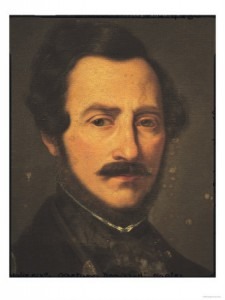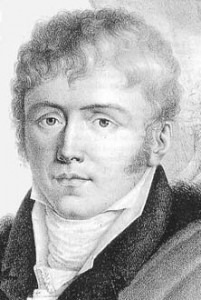
Donizetti
Simon Mayr: Elena, “Ah! Se mirar potessi”
Mayr’s operas enjoyed an increasingly large number of performances abroad, and Louis Spohr remarked, “Mayr has if not so much imagination as Rossini, yet, certainly, more knowledge and aesthetic feeling.” And the German musicologist Ludwig Schiedermair wrote, “Germany gave England a Handel, France a Gluck and Italy a Simone Mayr.” Under Mayr’s carefully tailored and supervised instruction — he even sent his young charge to Bologna to study counterpoint — Gaetano quickly developed into a capable musician and composer. His first operas enjoyed limited success, but Anna Bolena of 1830 represents a watershed in Donizetti’s career. The libretto deals with the Tudor period in English history, and after its overwhelming success at the Teatro Carcano in Milan, Donizetti, together with Bellini and Rossini “emerged as one of the three most luminous names in the world of Italian opera.” Furthermore, the work was subsequently performed in London and Paris, enabling Donizetti to embark on a highly successful international career.

Simon Mayr
Donizetti followed the resounding success of Anna Bolena with two additional serious operas, Lucrezia Borgia of 1833, and Lucia di Lammermoor of 1835. Both operas considerably influenced not only Verdi but Puccini as well. Solo numbers evolved into “a large-scale form in which monumentality of design and sophistication of internal workings interact and mutually support each other.” A more sophisticated dramatic characterization gradually caused the division into recitative and aria to be blurred, and introductory ‘scenas,’ as well as extended transitional sections between cavatina and cabaletta, consisted of arioso sections ranging in style over all “gradations from recitative to genuine aria.”
Gaetano Donizetti: Lucia di Lammermoor, Act III, Scene 1
Ardon gli incensi; splendon le sacre faci
Spargi d’amaro pianto
Rossini regarded Lucia di Lammermore as Donizetti’s supreme operatic achievement. It epitomized the Italian Romantic spirit of the 1830’s, and was composed in merely six weeks. First produced in Naples in 1835, the libretto closely follows the historical novel by Sir Walter Scott. Without doubt, it served as a model for the young Verdi, who looked upon Donizetti as an Italian composer who was highly successful in using French dramatic techniques on the Italian stage. Verdi improved Donizetti’s heritage of abandoning the sharp dichotomy between recitative and aria in favor of countless hybrid forms in unpredictable alternations, sensitively and minutely adapting the music to the demands of the drama. It has been suggested that the Verdi operas written between Oberto (1839) and Stiffelio (1850) owe their effectiveness in large measure to the dramatic efforts of Gaetano Donizetti.
Giuseppe Verdi: Luisa Miller, Act 2, Scene 1
Il padre tuo …
Tu puniscimi, o Signore
In 1844, Donizetti wrote, “My heyday is over, and another must take my place. The world wants something new. Others have ceded their places to us and we must cede ours to still others… I am more than happy to give mine to people of talent like Verdi.” Please join me next time for the final installment exploring the dramaturgy of Grand Opera and its influence on Giuseppe Verdi.

